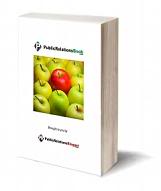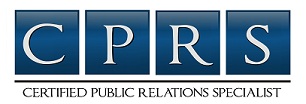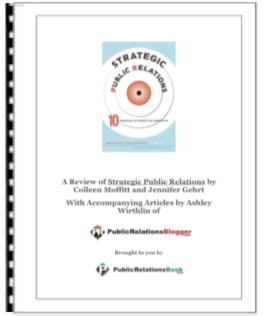________________________________________________________________________
 Considering how fundamental they are to the publicist’s trade, it’s always amazed me how lousy almost all press kits truly are. Your typical press kit is a bloated folder filled with puffery, hype, irrelevant information and worse. The vast majority of these monstrosities do little besides kill trees and clog newsroom trash baskets.
Considering how fundamental they are to the publicist’s trade, it’s always amazed me how lousy almost all press kits truly are. Your typical press kit is a bloated folder filled with puffery, hype, irrelevant information and worse. The vast majority of these monstrosities do little besides kill trees and clog newsroom trash baskets.
The good news is that creating a press kit that actually works really isn’t that hard. Let's look at the elements of a winning press kit, and help you avoid some common pitfalls.
The Psychology of a Press Kit
There are two fundamental rules to creating a good press kit:
1. The press kit exists to make the journalist’s life easier, not for you to present sales messages and hype. Good publicists are journalist-centric -- that is, they think from the perspective of the recipient, not the sender. They take the time to learn what journalists need and then they give it to them in as simple, straightforward and user-friendly a manner as possible. Remember, publicity is not about you -- it’s about giving journalists what they need to create a strong story.
2. Everything in the press kit goes to support your clincher. Everything else gets yanked out. (A refresher: a "clincher" is my term for the one or two line distillation of your publicity message. It’s the publicist’s version of the Universal Selling Proposition that marketers use to boil a product’s marketing message down to its essence.) You lay out your clincher in the pitch letter that gets clipped to the cover of the press kit, and the press kit serves to flesh out and support your clincher. That’s it. If your clincher is that you’ve brought a radical new way of thinking to your market segment, then a backgrounder about your "old fashioned commitment to excellence" not only doesn’t support your clincher, it may actually contradict it.
The Elements of a Press Kit
The Cover: In my twenty years as a publicist, I have never encountered a single journalist who told me the cover a press kit had the slightest impact on their decision whether to run a story. Yet, businesses still spend thousands on glossy, four color folder covers. Don’t bother. A simple colored folder with your business name imprinted upon it will work just fine.
Some businesses choose to get stickers printed up with their logo and place them on blank folders, which is fine too, as long as the stickers are neatly applied. Either way, don’t obsess over it -- it’s what’s inside that counts.
Letterhead: The first page of each press kit element should be on your letterhead. Some folks prefer to get special "News from (name of company)" letterhead printed, although, again, I doubt it really matters.
The Lead Release: If your press kit is going out in support of an announcement, an event, a trend story or for another specific purpose, the release that lays out the news should be the first thing a journalist sees upon opening the folder. This "lead release" should be positioned at the front of the right side of the folder.
Backgrounder: This is the element of your kit that provides, well, the background information to support your pitch. It’s written in the fashion of a standard news feature (i.e. in third person, objective tone). This is typically the longest element in a press kit, often going 2 or 3 pages. As you’re crafting this, keep something important in mind: if a journalist is reading your backgrounder, chances are he’s already interested in your pitch. If he wasn’t, he wouldn’t bother with it. You’ve hooked him and the backgrounder can reel him in. To do so, you must answer the two questions he has: "Is the claim made in the pitch legitimate?" and "Is there enough material here for me to do a story?"
Your pitch letter (based on your clincher) made a claim of some sort about you, your company or your product. You’re the fastest, the most advanced, the hottest-selling, the most civic-minded, etc. Now you have to back up your claim. Your backgrounder is where this happens. Provide proof, by giving concrete examples, third party observations, study results, etc. to support your pitch. If you’re claiming that there’s a trend taking place, here’s where you provide the statistics to back it up. If you’ve claimed that you’ve won more awards that anyone else in town, here’s where you describe them. Don’t stray from your purpose -- to reel in the journalist by convincing him that your claim is legit.
The backgrounder also must demonstrate that enough material exists to support the claim - and that it will be easy for the journalist to access this information. Journalists don’t have time to do extended investigation on every piece. Provides leads to websites, trade journals, experts and other resources to back up your claim and help the journalist complete the story, you’ll have a big edge.
To write a backgrounder, do some role playing. You’re a reporter. Your editor has handed you a pitch letter and said "write this up". In this case, of course, the pitch letter is your own. While you’re writing it, try to forget that the piece is, essentially, about you. Pretend you’re an objective reporter. Track down resources, dig up stats, interview experts. Try to see if you can create a credible piece that proves the pitch’s claim to be valid and interesting to the reader. If you can, you’ve got a great backgrounder. If you can’t, it may be time to come up with a new pitch!
Bio: Only include bios of people who are relevant to the pitch. A bio of your sales manager in a press kit designed to support a claim of technological superiority is pointless. A bio of your head of R&D is valid. Keep bios short (three paragraphs at the most) and include only information relevant to the pitch. The fact your head of R&D spent twenty years at NASA is relevant, that she loves golf and has two cats isn’t. The point of a bio: to show the legitimacy of those quoted in your release or being offered for interview, and to help the reporter craft a short description of the person when writing the piece.
Fact Sheet: The fact sheet should distill the entire press kit into an "at a glance" document. Keep it short, use bullet points and bold headings. For example, I might start with the heading The Story: and include a bullet point repeating the pitch. The next heading might be Why It’s Important: followed by some bullet points putting the pitch into a broader industry-wide (or perhaps even worldwide) context. Finally, I might use the heading Why (name of my company) is at the Heart of this Vital Story: and run some bullet points taken from the backgrounder giving support to my claim. Put this fact sheet at the front of the left side of the folder, just across from the lead release. This sort of fact sheet is amazingly powerful and almost never crafted in the fashion I just laid out. I’ve sold countless stories because of this style of fact sheet and you can too.
Other Stuff: Filling out the kit with a company brochure and a photo or two is reasonable, but don’t get carried away. Keep your kit simple, stick to your clincher and think like a journalist, not a marketer, and you’ll have crafted a first class press kit!
Bill Stoller, the "Publicity Insider", has spent two decades as one of America's top publicists. Now, through his website, eZine and subscription newsletter, Free Publicity: The Newsletter for PR-Hungry Businesses, he's sharing -- for the very first time -- his secrets of scoring big publicity. For free articles, killer publicity tips and much, much more, visit Bill's exclusive new site.
Article Source.
Tags: press kits, elements that work, public relations, PR
Elements of a Press Kit That are Effective
________________________________________
 Considering how fundamental they are to the publicist’s trade, it’s always amazed me how lousy almost all press kits truly are. Your typical press kit is a bloated folder filled with puffery, hype, irrelevant information and worse. The vast majority of these monstrosities do little besides kill trees and clog newsroom trash baskets.
Considering how fundamental they are to the publicist’s trade, it’s always amazed me how lousy almost all press kits truly are. Your typical press kit is a bloated folder filled with puffery, hype, irrelevant information and worse. The vast majority of these monstrosities do little besides kill trees and clog newsroom trash baskets.The good news is that creating a press kit that actually works really isn’t that hard. Let's look at the elements of a winning press kit, and help you avoid some common pitfalls.
The Psychology of a Press Kit
There are two fundamental rules to creating a good press kit:
1. The press kit exists to make the journalist’s life easier, not for you to present sales messages and hype. Good publicists are journalist-centric -- that is, they think from the perspective of the recipient, not the sender. They take the time to learn what journalists need and then they give it to them in as simple, straightforward and user-friendly a manner as possible. Remember, publicity is not about you -- it’s about giving journalists what they need to create a strong story.
2. Everything in the press kit goes to support your clincher. Everything else gets yanked out. (A refresher: a "clincher" is my term for the one or two line distillation of your publicity message. It’s the publicist’s version of the Universal Selling Proposition that marketers use to boil a product’s marketing message down to its essence.) You lay out your clincher in the pitch letter that gets clipped to the cover of the press kit, and the press kit serves to flesh out and support your clincher. That’s it. If your clincher is that you’ve brought a radical new way of thinking to your market segment, then a backgrounder about your "old fashioned commitment to excellence" not only doesn’t support your clincher, it may actually contradict it.
The Elements of a Press Kit
The Cover: In my twenty years as a publicist, I have never encountered a single journalist who told me the cover a press kit had the slightest impact on their decision whether to run a story. Yet, businesses still spend thousands on glossy, four color folder covers. Don’t bother. A simple colored folder with your business name imprinted upon it will work just fine.
Some businesses choose to get stickers printed up with their logo and place them on blank folders, which is fine too, as long as the stickers are neatly applied. Either way, don’t obsess over it -- it’s what’s inside that counts.
Letterhead: The first page of each press kit element should be on your letterhead. Some folks prefer to get special "News from (name of company)" letterhead printed, although, again, I doubt it really matters.
The Lead Release: If your press kit is going out in support of an announcement, an event, a trend story or for another specific purpose, the release that lays out the news should be the first thing a journalist sees upon opening the folder. This "lead release" should be positioned at the front of the right side of the folder.
Backgrounder: This is the element of your kit that provides, well, the background information to support your pitch. It’s written in the fashion of a standard news feature (i.e. in third person, objective tone). This is typically the longest element in a press kit, often going 2 or 3 pages. As you’re crafting this, keep something important in mind: if a journalist is reading your backgrounder, chances are he’s already interested in your pitch. If he wasn’t, he wouldn’t bother with it. You’ve hooked him and the backgrounder can reel him in. To do so, you must answer the two questions he has: "Is the claim made in the pitch legitimate?" and "Is there enough material here for me to do a story?"
Your pitch letter (based on your clincher) made a claim of some sort about you, your company or your product. You’re the fastest, the most advanced, the hottest-selling, the most civic-minded, etc. Now you have to back up your claim. Your backgrounder is where this happens. Provide proof, by giving concrete examples, third party observations, study results, etc. to support your pitch. If you’re claiming that there’s a trend taking place, here’s where you provide the statistics to back it up. If you’ve claimed that you’ve won more awards that anyone else in town, here’s where you describe them. Don’t stray from your purpose -- to reel in the journalist by convincing him that your claim is legit.
The backgrounder also must demonstrate that enough material exists to support the claim - and that it will be easy for the journalist to access this information. Journalists don’t have time to do extended investigation on every piece. Provides leads to websites, trade journals, experts and other resources to back up your claim and help the journalist complete the story, you’ll have a big edge.
To write a backgrounder, do some role playing. You’re a reporter. Your editor has handed you a pitch letter and said "write this up". In this case, of course, the pitch letter is your own. While you’re writing it, try to forget that the piece is, essentially, about you. Pretend you’re an objective reporter. Track down resources, dig up stats, interview experts. Try to see if you can create a credible piece that proves the pitch’s claim to be valid and interesting to the reader. If you can, you’ve got a great backgrounder. If you can’t, it may be time to come up with a new pitch!
Bio: Only include bios of people who are relevant to the pitch. A bio of your sales manager in a press kit designed to support a claim of technological superiority is pointless. A bio of your head of R&D is valid. Keep bios short (three paragraphs at the most) and include only information relevant to the pitch. The fact your head of R&D spent twenty years at NASA is relevant, that she loves golf and has two cats isn’t. The point of a bio: to show the legitimacy of those quoted in your release or being offered for interview, and to help the reporter craft a short description of the person when writing the piece.
Fact Sheet: The fact sheet should distill the entire press kit into an "at a glance" document. Keep it short, use bullet points and bold headings. For example, I might start with the heading The Story: and include a bullet point repeating the pitch. The next heading might be Why It’s Important: followed by some bullet points putting the pitch into a broader industry-wide (or perhaps even worldwide) context. Finally, I might use the heading Why (name of my company) is at the Heart of this Vital Story: and run some bullet points taken from the backgrounder giving support to my claim. Put this fact sheet at the front of the left side of the folder, just across from the lead release. This sort of fact sheet is amazingly powerful and almost never crafted in the fashion I just laid out. I’ve sold countless stories because of this style of fact sheet and you can too.
Other Stuff: Filling out the kit with a company brochure and a photo or two is reasonable, but don’t get carried away. Keep your kit simple, stick to your clincher and think like a journalist, not a marketer, and you’ll have crafted a first class press kit!
Bill Stoller, the "Publicity Insider", has spent two decades as one of America's top publicists. Now, through his website, eZine and subscription newsletter, Free Publicity: The Newsletter for PR-Hungry Businesses, he's sharing -- for the very first time -- his secrets of scoring big publicity. For free articles, killer publicity tips and much, much more, visit Bill's exclusive new site.
Article Source.
Tags: press kits, elements that work, public relations, PR
Popular choices
- Non Gamstop Casino
- Mejores Salas De Póker
- Casino Non Aams
- Non Gamstop Casinos
- Siti Casino Online Non Aams
- Migliori Siti Casino Online
- UK Online Casinos Not On Gamstop
- Non Gamstop Casino Sites UK
- Non Gamstop Casino Sites UK
- UK Casino Not On Gamstop
- Casinos Not On Gamstop
- Online Casino
- オンラインカジノ
- UK Casino Not On Gamstop
- UK Casino Not On Gamstop
- Reputable Non Gamstop Casinos
- Casinos Not On Gamstop
- Best Non Gamstop Casinos
- Non Gamstop Casino
- Casinos Not On Gamstop
- Slots Not On Gamstop
- Non Gamstop Casino
- Casino Non Aams
- Casinos Not On Gamstop
- Betting Sites Not On Gamstop
- Casino Online Italia
- Casino En Ligne Belgique
- Sites De Paris Sportif Fiables
Subscribe to:
Post Comments (Atom)






Comments (0)
Post a Comment